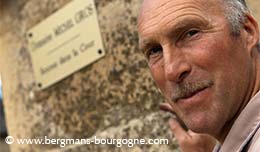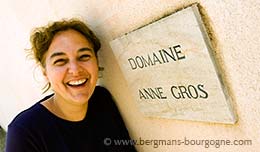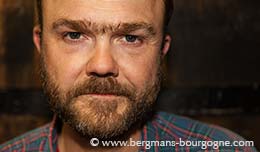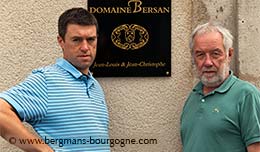
ouis-Michel Liger-Belair already had La Romanée, the minuscule Vosne-Romanée grand cru just above Romanée-Conti. Then there is the Vosne-Romanée, Clos du Château, an equally tiny monopole on village level. More recently he went shopping in Nuits-Saint-Georges, where he picked up Clos des Grandes Vignes, the only premier cru east of the Beaune-Dijon road.
– I love the monopoles, he says. This is the third one. It’s good from a commercial point of view and it’s good because people will not compare it with other wines from the same climat. And if you have a clos that is a monopole it also means you have no pollution from the neighbours.
Today’s Domaine du Comte Liger-Belair in Vosne-Romanée is a fairly young thing. The history goes way back, but it was not until 2000 that Louis-Michel Liger-Belair took on the family estate and brought back the vineyards. At the start there was only 3.2 hectares and five wines. In 2006 the portfolio increased to 14 wines and 8.3 hectares.
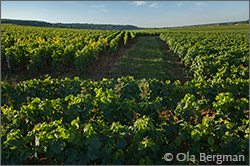 – Clos des Grandes Vignes is located in Prémeaux-Prissey and it covers 2.2 hectares, which brings the domaine up to a total of 10.5 hectares, says Louis-Michel Liger-Belair. This premier cru is not particularly well-known. When Dujac and de Montille bought Domaine Thomas-Moillard it did not fit either of their portfolios, so they put it up for sale. For me it was good. Not too big and the vines are old.
– Clos des Grandes Vignes is located in Prémeaux-Prissey and it covers 2.2 hectares, which brings the domaine up to a total of 10.5 hectares, says Louis-Michel Liger-Belair. This premier cru is not particularly well-known. When Dujac and de Montille bought Domaine Thomas-Moillard it did not fit either of their portfolios, so they put it up for sale. For me it was good. Not too big and the vines are old.
He describes his playground as the part of the Côte d’Or stretching from Chambolle-Musigny, via Vougeot and Vosne-Romanée, to Nuits-Saint-Georges. Last year he was offered some land in Gevrey-Chambertin, but turned it down.
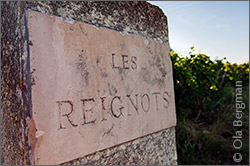 – Clos des Grandes Vignes has a mix of clay and limestone. It is at the bottom of the slope, which means it is more clay than limestone. The soil is not very deep though.
– Clos des Grandes Vignes has a mix of clay and limestone. It is at the bottom of the slope, which means it is more clay than limestone. The soil is not very deep though.
In the future the Clos des Grandes Vignes will be producing three cuvées – two red and one white. 2012 will be the first vintage for two of them.
– There will be a grande cuvée, says Louis-Michel Liger-Belair, and there will be a second wine from the 0.6 hectare that have been uprooted. It is the bottom part and since it is probably a bit more wet there we will improve the drainage. The third is from 0.35 hectare of chardonnay. That’s the fun part.
He is smiling when he is talking about the chardonnay vines, well aware that he has gone on record saying that, as a winemaker, you can’t excel in both colours.
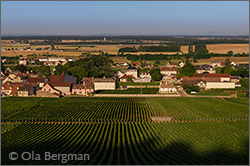 – You can be good, but not excellent. There are just a few estates that are excellent in both colours. Two very different jobs. It is a bit like running marathons or short distances.
– You can be good, but not excellent. There are just a few estates that are excellent in both colours. Two very different jobs. It is a bit like running marathons or short distances.
– Making red wine is the short distance. White is the marathon. Making red wine means you have one month of really intense work, you have to be attentive all the time during that period. For the whites we are talking about three, four or five months. It is not as intensive, but you have to be there every day.
Louis-Michel Liger-Belair is not sure of the outcome. He is looking forward to the project, saying that it will require time and effort to find their own way of making white wine at the domaine. If it in the end turns out that his white is ”just” good, he is not sure if he will be happy with that or not.
– There is always the possibility of re-grafting with pinot noir, he smiles.
 Domaine du Comte Liger-Belair has two more wines from Nuits-Saint-Georges, premier cru in Aux Cras and village wine in Aux Lavières. The rest is all in Vosne-Romanée and Flagey-Echézeaux – Vosne-Romanée (from eleven or twelve different lieux-dits), Vosne-Romanée Clos du Château and Vosne-Romanée La Colombière; five Vosne-Romanée premier crus – Les Chaumes, Les Suchots, Aux Reignots, Les Petits Monts and Les Brulées (the latter only bottled in magnums and jeroboams for special occasions, not available on the market); two grand crus La Romanée and Echézeaux.
Domaine du Comte Liger-Belair has two more wines from Nuits-Saint-Georges, premier cru in Aux Cras and village wine in Aux Lavières. The rest is all in Vosne-Romanée and Flagey-Echézeaux – Vosne-Romanée (from eleven or twelve different lieux-dits), Vosne-Romanée Clos du Château and Vosne-Romanée La Colombière; five Vosne-Romanée premier crus – Les Chaumes, Les Suchots, Aux Reignots, Les Petits Monts and Les Brulées (the latter only bottled in magnums and jeroboams for special occasions, not available on the market); two grand crus La Romanée and Echézeaux.
Louis-Michel Liger-Belair does not agree with the criticism that not all 38 hectares of Echézeaux are not worthy of grand cru status.
 – I think 98 per cent of Echézeaux is really grand cru, he says. It’s a misunderstanding of what a grand cru should be, not by the clients, but by the winegrowers. They think a grand cru must be a ”more” wine. More of everything. Must be oaky. Must be more alcoholic. Must be more acidic. Must be more tannic. But this is not the case.
– I think 98 per cent of Echézeaux is really grand cru, he says. It’s a misunderstanding of what a grand cru should be, not by the clients, but by the winegrowers. They think a grand cru must be a ”more” wine. More of everything. Must be oaky. Must be more alcoholic. Must be more acidic. Must be more tannic. But this is not the case.
The Echézeaux of Domaine du Comte Liger-Belair is a blend of different parcels within the appellation. Two thirds come from Cruots and Vignes Blanches on the Vosne-Romanée side. One third comes from Champs Traversins in the steeper part of Echézeaux.
Louis-Michel Liger-Belair stresses the importance of knowing your history, knowing where you are coming from. As he points out, he has very lucky – born in Vosne-Romanée, with La Romanée and the Château de Vosne-Romanée in the family.
 – Now the wine market is great, he says. Just don’t forget that 30 years ago it wasn’t so easy. We have been one of the leading families in Burgundy for about one century. There was the peak in the 1920’s and the bottom in the 1930’s. My father was born in 1928. He was born in one of the wealthiest families in Burgundy. When he was five everything was sold and it was one of the poorest families in Vosne-Romanée.
– Now the wine market is great, he says. Just don’t forget that 30 years ago it wasn’t so easy. We have been one of the leading families in Burgundy for about one century. There was the peak in the 1920’s and the bottom in the 1930’s. My father was born in 1928. He was born in one of the wealthiest families in Burgundy. When he was five everything was sold and it was one of the poorest families in Vosne-Romanée.
For various reasons not many old vintages have been saved in the cellars of the Château de Vosne-Romanée. But Louis-Michel Liger-Belair has had the chance to taste old vintages of the family’s wines elsewhere, most recently a vertical tasting of 41 vintages of La Romanée.
– When you do a blind tasting like that you see the style of winemaker quite easily. But there is also a continuity between all the wines, the soul of the wine.
– I have tasted some 1923’s, the last vintage of my great-grandfather. I felt there was a family style, even if I have never met my great-grandfather. I feel we have the same winemaking approach. What he did then is similar to what I do now. It is there, in the wine.
© 2012 Ola Bergman










